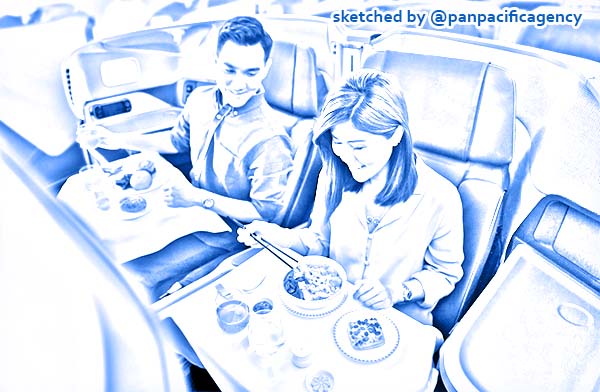SIA, Cathay Pacific, Far East Hospitality to get fillip from planned travel bubble

Business-class dining will cost $300, excluding GST. PHOTO: SINGAPORE AIRLINES. Sketched by the Pan Pacific Agency.
SINGAPORE, Oct 16, 2020, BT. Aviation and hospitality stocks listed in Singapore and Hong Kong are set to see a boost from the upcoming two-way air travel bubble between the two major Asian financial hubs, The Business Times reported.
Flag carriers Singapore Airlines (SIA) and Cathay Pacific Airways, in particular, will be among the beneficiaries, the DBS and Jefferies research teams said in separate reports on Friday.
Hong Kong and Singapore this week agreed in principle to form an air travel bubble for all travel purposes, without quarantine or stay-home-notice requirements for arrivals. Anyone who has stayed 14 days in either territory will be eligible to travel.
This could spark keen interest from both leisure and business travellers, especially if it takes off in time for the year-end holidays, travel agencies said.
The start date of the bubble is unknown, but Singapore Transport Minister Ong Ye Kung on Thursday said he hoped to see it kick off in a matter of weeks.
Last year, more than 450,000 visitors from Singapore made their way to Hong Kong. Likewise, Hong Kong was one of Singapore’s top sources of visitors, bringing in about 490,000 people or 3 per cent of the city’s total last year, DBS Group Research noted.
The news will thus give a fillip to Singapore’s hospitality sector, which may see improved occupancies, DBS analyst Yeo Kee Yan wrote on Friday.
He added that his top picks are SIA, SATS and Far East Hospitality Trust (FEHT).
SIA had operated as many as seven flights daily from Singapore to Hong Kong before the Covid-19 pandemic hit, Mr Yeo said.
DBS has a “hold” call on the flag carrier with a price target of S$3.75. SIA’s stock price gained S$0.03 or 0.9 per cent to trade at S$3.52 as at 2.42pm on Friday, with 1.4 million shares changing hands.
On Thursday, SIA also reported that its group passenger capacity fell 90.8 per cent on the year in September. In contrast, its cargo load factor rose 29.5 per cent year on year as the capacity contraction outpaced the drop in cargo traffic.
DBS also favours ground handler and in-flight catering firm SATS, which the analyst said will benefit from an improvement in air traffic. Mr Yeo has a “buy” rating and S$3.66 price target on the stock.
SATS fell S$0.04 or 1.3 per cent to S$3.03 as at 2.43pm on Friday, with close to 2.6 million shares traded.
DBS also likes FEHT, saying the hospitality play is a “buy” with a price target of 60 Singapore cents. FEHT’s hotels and serviced residences are primarily located in Singapore’s core central region, along the Orchard Road shopping belt, Marina Bay and Singapore River, as well as the Civic and Cultural District, which saw high volumes of business and leisure travellers before the coronavirus pandemic.
FEHT stapled securities were trading at 55.5 Singapore cents as at 2.44pm, down 0.5 cent or 0.9 per cent.
In another report, Jefferies equity analyst Andrew Lee said he believes the initial number of flights available under the Singapore-Hong Kong air travel bubble could be limited.
He also highlighted that the news drove Cathay Pacific’s stock price to rebound by 6 per cent on Thursday. The Hong Kong carrier’s shares rose further to trade at HK$5.82 as at 1.15pm on Friday, up HK$0.21 or 3.7 per cent.
Although the timing of the bubble is unknown, the plan is positive for Cathay Pacific, which has seen its total passenger traffic shrink by more than 95 per cent in the past five months for its Hong Kong-Singapore flights, wrote Mr Lee.
Moreover, Cathay Pacific used to command the biggest market share on this route before the pandemic. Jefferies estimates that in the second half of 2019, the airline operated 44 per cent of total flights from Hong Kong to Singapore, more than the 38 per cent market share held by SIA.
But even as the planned travel bubble may deliver a shot in the arm for Cathay Pacific, cash burn is also likely to increase due to route startup costs.
Its cash burn rate of about HK$1.5 billion to HK$2 billion (S$263.4 million to S$351.2 million) per month is likely to increase when new routes are reinstated, considering the initial low load factors and startup costs, Mr Lee noted.
And although Jefferies expects the airline’s management to announce details of its restructuring plans in November, the potential air travel bubble could change part of these plans. The analyst added that headcount reductions at Cathay Pacific would still be inevitable as passenger traffic is likely to recover slowly.
Jefferies on Friday maintained its “hold” call, pending details of the restructuring plans. It also kept the price target of HK$6.30 on the stock based on 0.6-time forward price-to-book value, given the ongoing losses, low likelihood of earnings rebounding in the near term and uncertainty around the timing of reintroduced routes.
Less than a day after the planned Singapore-Hong Kong bubble was announced, the cost of air tickets between the cities has already started to climb.
The cheapest price for a return economy seat on SIA to Hong Kong was S$558 on Friday morning up until the end of December, versus around S$400 on Thursday afternoon as the news was being announced, Bloomberg reported. Return business-class fares rose by around HK$5,000 to HK$19,000.
Aside from its proposed travel bubble with Singapore, Hong Kong also has potential ones with 10 other markets – Australia, France, Germany, Japan, Malaysia, New Zealand, South Korea, Switzerland, Thailand and Vietnam.